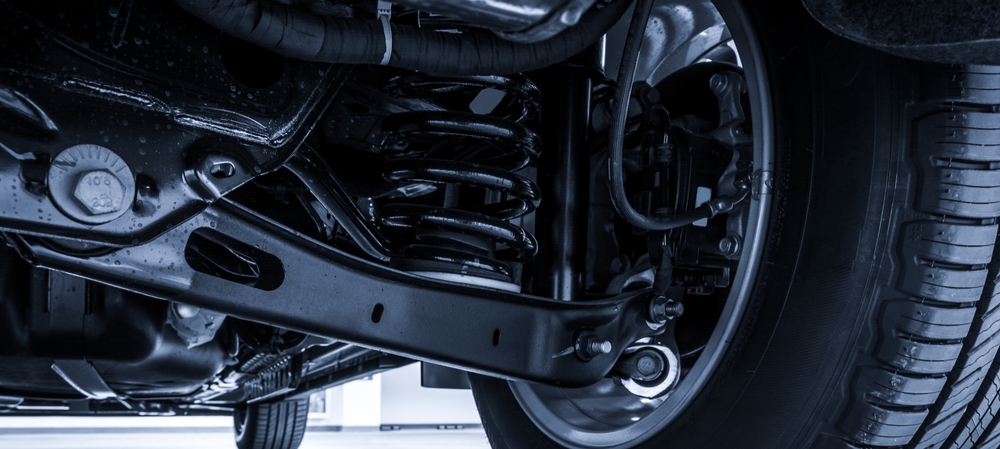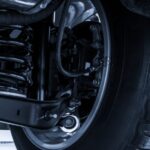
31 Mar Suspension | Auto Stability Triangle Part 2
 The suspension, tires, and wheel alignment are the three legs found in the auto stability triangle. In this blog, we will focus on suspension. Your vehicle’s suspension does several things: It improves the ride quality, supports the vehicle’s weight on the chassis, and keeps all the tires in contact with the ground. Keep reading to find out how shocks & struts, springs, and an anti-sway bar aids the suspension system and contributes to auto stability. Additionally, I discuss common suspension problems and offer maintenance interval suggestions.
The suspension, tires, and wheel alignment are the three legs found in the auto stability triangle. In this blog, we will focus on suspension. Your vehicle’s suspension does several things: It improves the ride quality, supports the vehicle’s weight on the chassis, and keeps all the tires in contact with the ground. Keep reading to find out how shocks & struts, springs, and an anti-sway bar aids the suspension system and contributes to auto stability. Additionally, I discuss common suspension problems and offer maintenance interval suggestions.
How Does Suspension Work?
The suspension system in your automobile absorbs the bumps caused by driving over irregular road surfaces. It also counter-balances the chassis to prevent your vehicle from excessive body roll when cornering, accelerating, or braking. Finally, the suspension supports the weight of the automobile on the chassis by keeping all four wheels on the ground.
Different Types of Suspension
Vehicles may come equipped with two basic types of suspensions: Dependent and Independent. Some automobiles will have only one type, while other vehicles will have both types. Read your owner’s manual to determine which system your make & model vehicle utilizes.
Dependent Suspension
Many older vehicles come equipped with dependent suspension systems. Usually, a dependent suspension connects the right and left wheels via an axel tube housing or an axel beam. Dependent suspensions utilize shock absorbers with either a coil, leaf, or torsion spring. While this type of suspension is strong and straightforward, it results in a less comfortable ride since bumps in the road are transferred to both sides of the car.
Independent Suspension
Most modern vehicles come equipped with an independent suspension. Independent suspension systems permit each wheel to move independently (thus the name) since an axle does not connect them. Motorists can appreciate better handling and a more comfortable ride with this type of suspension. They are also lighter-weight and more compact.
Suspension Components
Let’s explore how the suspension, tires, and alignment work together to form the Auto Stability Triangle. First, we will focus on the suspension components. Most modern vehicles incorporate shocks & struts, springs, and anti-sway bars in their suspension system.
Shocks & Struts
Shocks & struts (or dampeners) control the motion of the various types of springs in the suspension system.
- Each corner of the vehicle have shocks installed near the springs. Basically, they are sealed tubes filled with hydraulic fluid. With each depression of the springs, a piston inside the tube pushes the fluid through a series of holes and valves. The fluid slows the rebound motion and provides stability to the vehicle.
- Engineers designed struts to be an all-in-one shock and spring assembly. They work the same way as separate shocks and springs but in a more compact unit. They are economical and easily serviced. The shock and spring components are replaceable when necessary.
Springs
Springs are the main component of the vehicle’s suspension system. They support the weight of the automobile, cargo, and passengers while maintaining enough road clearance, so the frame doesn’t bottom out. Springs are also responsible for a smooth ride by allowing the wheels to move up and down over uneven road surfaces. There are many different types of springs used in motor vehicles.
- Air Spring – cylinder filled with compressed air
- Hydraulic Spring – hydraulic fluid pressurized by a pump and controlled by sensors
- Leaf Spring – arc-shaped metal ‘leafs’ stacked and clamped on top of each other
- Steel Coil Spring – heavy-duty solid steel coil
- Torsion Bar – long straight metal rod that mounts to the chassis on one end and a control arm, spindle, or axle on the other
Anti-Sway Bar
An anti-sway bar ties one side of the vehicle’s suspension to the other. It mounts to the frame or chassis with bushings. Each end of the anti-sway bar connects to the spindle or control arm. The main purpose of the anti-sway bar is to reduce body roll when turning corners and keep the tires firmly on the road.
Common Suspension Problems
Luckily, most modern vehicles do not require a lot of suspension maintenance. However, problems can occur out of the blue or develop slowly over time. Let’s look at some common suspension problems and how to spot them. If you suspect your vehicle’s suspension needs service, bring it to your local service station right away.
Blown or Damaged Shocks, Struts, or Springs:
- Automobile sits lower on one side or corner
- Chassis rocks or bucks after driving over a pot hole or rough road
- Passengers feel jostled or bounced around in the cabin
- Difficulty steering
- Vehicle is involved in a collision
Suspension Service Intervals
Many vehicles will indicate when to have your suspension serviced in the owner’s manual. It is wise to follow those recommendations to keep your vehicle running safely. However, in some cases, the manufacturer may not indicate a specific service interval. In that case, a good rule of thumb is to schedule a suspension service every 15,000 miles.
Schedule Service in Plymouth Meeting, PA
The highly trained technicians at Plymouth Auto & Tire Center will gladly answer all your auto stability maintenance service questions. Call us today at (610) 825-6558 or visit us online to schedule service today!
Next Up in Blog Series
Auto Stability Triangle Part 3 | Wheel Alignment

